-
Paper Information
- Next Paper
- Paper Submission
-
Journal Information
- About This Journal
- Editorial Board
- Current Issue
- Archive
- Author Guidelines
- Contact Us
American Journal of Sociological Research
p-ISSN: 2166-5443 e-ISSN: 2166-5451
2015; 5(4): 101-118
doi:10.5923/j.sociology.20150504.02

Exploration of Sustainable Urban Qualities of Al Sadd Area in Doha
Nussyba Eiraibe , ALMaha Ahmed AL-Malki , Raffaello Furlan
College of Engineering Department of Architecture and Urban Planning, Qatar University, Doha, Qatar
Correspondence to: Raffaello Furlan , College of Engineering Department of Architecture and Urban Planning, Qatar University, Doha, Qatar.
| Email: |  |
Copyright © 2015 Scientific & Academic Publishing. All Rights Reserved.
This work is licensed under the Creative Commons Attribution International License (CC BY).
http://creativecommons.org/licenses/by/4.0/

This research focuses on the contributions made to social sustainability, firstly by the functionality of urban spaces in Qatar, as defined by their physical form, and secondly by the socio-cultural attributes of those areas. The urban area addressed in this research is Al Sadd area, located in Doha, Qatar. Data is collected from both primary and secondary sources; the research methodologies were questionnaires, which targeted fifty users of the Al Sadd area, and initial ‘walk through observations’ of several areas of the Al Sadd neighborhood. The objective of this research is to explore urban qualities within the region, the meanings, who construct them, what are the parameters which are guiding those areas and what makes them sustainable. This exploration would allow understanding the context in which those urban areas are constructed and what makes them sustainable in the long term. The main findings related to the social sustainability of Al Sadd were: (1) population characteristics of the area and their needs are not properly addressed in the neighborhood design, where most of them are immigrant workers, (2) the architecture of the area lacks a distinguishing character, that sets it apart from other neighborhoods, and lastly (3) the urban design and lack of well defined open spaces, does not help in fostering social interaction between different groups.
Keywords: Sustainable Urbanism, Social Sustainability, Urban Practice, Urban Quality, Al Sadd, Doha
Cite this paper: Nussyba Eiraibe , ALMaha Ahmed AL-Malki , Raffaello Furlan , Exploration of Sustainable Urban Qualities of Al Sadd Area in Doha, American Journal of Sociological Research, Vol. 5 No. 4, 2015, pp. 101-118. doi: 10.5923/j.sociology.20150504.02.
Article Outline
1. Introduction
- The United Nations (1987) defines ‘sustainable’, developments that “meet the needs of the present without compromising the needs of future generations”. According to Hass (2012), “Sustainability means maintaining growth or maintaining the organism in a healthy mature state, or, sustainability could mean maintaining a “harmonious balance” between organism and environment” (Hass 2012, Pg. 59). In the urban context, sustainability can be achieved only if the social, economic and environmental aspects are understood in relation to each other. The three bases for the sustainable urbanism are mainly: (1) the urban structure managed by wise urban governance, which is the key to improving the ecological balance of cities. (2) The basis for continuous economic growth, which is through the urban diversity, that creates the interdependencies and interactions between investors, and (3) the identification process between all social groups and the urban environment, which is the basis for social equity and creates the urban identity. The healthy urban society is an indicator of the urban identity (Lalli 1992, Pg. 286). Furthermore, forming an urban identity aids in establishing social equity and contributes to economic growth and ecological balance. It is the latter aspect of sustainable urbanism that our research will focus upon.With the purpose of creating and enhancing livable neighborhoods, many theories were proposed in the early 20th century. New initiatives in neighborhood planning developed as a result of the emergence of the concept of sustainable development and the emphasis it places on the local level (Farr 2008; Rohe 2009; Wheeler 2004). Sustainable neighborhood initiatives can be regarded as a continuation of urban planning and design trends, which sought to develop livable and environmentally friendly neighborhoods from the early 20th century onwards, starting with Ebenezer Howard’s Garden City Movement (Farr, 2008). These were responding to the needs of a diverse range of community groups to improve the livability of their urban areas and enhance the intergenerational equity of urban development.In the mid 20th century, the Qatar state began its rapid transformation into a modern urban society, mainly due to the remarkable increase in national income from the oil and gas industry. (Florian W and Ashraf S. 2013, 146-159). Doha city, the capital of Qatar, has grown from a single core and expanded to include new urban districts developments. To diversify Qatar’s economy many new development strategies had been applied, for example Qatar Foundation in collaboration with the World Bank have been diligently working on targeting the transition of Qatar towards a more knowledge-based economy, which implies that Qatar would be better equipped to compete in the global economy, and that its citizens would have a common platform and vision for their future.The main two variables that have influenced the urban areas in Qatar, as in other urban areas in the world are: physical and functional qualities, and social and cultural characteristics. This research aim is to find ways to sustain the social functionality of urban spaces in Qatar by focusing in Al Sadd neighborhood area and by taking a deeper look at its qualities. The research questions addressed within this study are the following:1. How is architectural form related to built heritage?2. How does the spatial form of Al Sadd encourage the formation of community interactions and engagement (indications of a healthy urban society and urban identity, and degree of social capital)?3. How can the spatial form of Al Sadd be improved in order to enhance social interactions?
2. Literature Review
2.1. Central Concepts and Definitions
- The central concepts of this research are sustainable urbanism, social sustainability and place- making. Sustainable urbanism refers to the conservation of cultural heritage, and developing strategies for promoting culturally and environmentally sensitive strategies for urban development. On the other hand, social sustainability is the least defined and least understood of the different ways of approaching sustainability and sustainable development. Social sustainability has had considerably less attention in public dialogue than economic and environmental sustainability. “Social sustainability is a quality of societies. It signifies the nature societal relationships, mediated by work, as well as relationships within the rest of society. Social sustainability is achieved, if work within a society and the related institutional arrangements satisfy an extended set of human needs and are shaped in a way that nature and its reproductive capabilities are preserved over a long period of time and the normative claims of social justice, human dignity and participation are fulfilled”1. Lastly, place making is a people-centered approach to the planning, design and management of public spaces. Put simply, it involves looking at, listening to, and asking questions of the people who live, work and play in a particular space, to discover their needs and aspirations. This information is then used to create a common vision for that place. The vision can evolve quickly into an implementation strategy, beginning with small-scale, do-able improvements that can immediately bring benefits to public spaces and the people who use them2.
2.2. Background
- The concept of sustainable development has become a term whose use has become increasingly frequent and widespread over the past three decades, although there is still no single, universally accepted definition of sustainability. As a common thread, most definitions emphasize the importance of integrating social, economic, environmental, and institutional dimensions (Boyoko, Cooper, Davey, & Wootton, 2006; Sharifi & Murayama, 2013; Valentin & Spangenberg, 2000). Interest in pursuing sustainability goals, through planning at the neighborhood level, has been growing in the recent years, and sustainability principles are increasingly used to guide neighborhood development (Luederitz, Lang, & Von Wehrden, 2013). Farr (2008) proposes sustainable urbanism, a comprehensive reform, as an achievable remedy to the effects caused by the American lifestyle (i.e. growing obese, economic cost, indoor activities, non-walkable urban spaces, etc.), and as an outline for courses in planning, architecture, engineering, environmental studies and interdisciplinary sustainable development. Farr (2008) further defines Sustainable Urbanism parameters as: density (compactness), sustainable corridors, biophilia (human access to nature), high-performance buildings and infrastructure, sustainable neighborhoods (identifiable center and edge to the neighborhood, walkable size, mix of land uses and housing types, integrated network of walkable streets). On a similar note, Wiedmann, F., Salama, A., & Mirincheva, V. (2014) emphasize the role of governance in establishing urban efficiency: five main hub visions can be distinguished, based on recently initiated public development strategies: The investment hub, The transit hub, The cultural hub, The knowledge hub, The political hub (Wiedmann, F., Salama, A., & Mirincheva, V. (2014), Pg. 7-8). “Sustainable Urbanism may be an answer to many questions referring to how places should grow, how people should get from one place to another and how people could live more sustainably. Sustainable urbanism has three basic aspects: environmental, social and economic. In environmental terms, this urban form enables people to walk to amenities rather than using a car and therefore dwellings, retail, leisure and commercial uses are put into much closer and walkable proximity with effective public transport connections; Socially, sustainable urbanism contains an appropriate set of spaces and buildings with different sizes and types for a mix of community activities; In economic terms, sustainable developments involve business activities and opportunities capable of providing jobs for many of their inhabitants” (The Princes Foundation, 2007).An urban space, when studied from a social perspective, should be based on the beliefs of the people, and their needs should be addressed through its physical design with regards to the biggest influencing factor, which is culture. In Montero-Avilo's (2001) research paper, ‘Factors that Influence the Social life and Vitality of Public Open Spaces in Maracaibo – Venezuela’, she employs two main case studies to compare and contrast; and to show how the open spaces have an important role in the social life of the city. However, Maria Cristina D. Lay and Antônio Reis (2003) in their article, ‘The Influence of Physical Changes in Communal Open Spaces on Performance Evaluation of Housing Schemes’, discuss that the enjoyment of people in the open space is not only determined by how it is physically attractive, but also by how the people perceive the space and the meaning they conjure from it. In their words:... “visual appearance does not exclusively relate to formal and aesthetic qualities: even when architectural elements present an attractive composite structure, it does not constitute a sufficient condition to guarantee perception of positive visual appearance. Residents tend to evaluate visual appearance based on their perception of attributes that express or not their values, preferences and social aspirations, which are related to specific characteristics of buildings and open spaces, and overall maintenance.’’ (Lay & Reis 2003, p. 124)Good urban design supports a mixture of activities, distinctive use of space, form and materials, and offers diverse sensory experiences (City of Melbourne, 2006). Mixing uses has many social and visual benefits including social contacts that stimulate community spirit and participation as well as providing visual details at a human scale (City of Melbourne, 2006). Mario and Richard (2000), define "social sustainability" as "development... compatible with the harmonious evolution of civil society, fostering an environment conducive to the compatible cohabitation of culturally and socially diverse groups while at the same time encouraging social integration, with improvements in the quality of life for all segments of the population"(Mario P and Richard S. (2000), Pg. 15-16). Furthermore, social sustainability may refer to equitable access to housing and facilities, well-developed community networks that help build trust and respect, and place making that encourages a sense of identity (Gilchrist 2000). The majority of the literature reviewed emphasized the importance of governance and the large role it plays in imposing laws regarding the urban form, which can aid the planning process. It is essential to identify the changes in the design of urban spaces and how their meanings have changed with differences in experiences, the increase in cultural diversity etc. Furthermore, it is important to understand the requirements of urban space and how much influence it plays in the public life through its physical form; how it is represented according to the social and cultural attributes of the place it belongs to; and how it is exhibited in the literature reviewed, to be able to evaluate the need for it and to identify the steps needed in order to tackle it within the context of the city of Doha.
2.3. The Significance of Al Sadd Area
- Al Sadd area is a neighborhood under the municipality of Doha. It consists mainly of residential blocks in the center, and mixed use developments and institutional buildings on the peripheries of Al Sadd area, as can be seen in Appendix I fig (1) ‘The land use of Al Sadd area’. In 2010 the population in Al Sadd area was 14,113. The settlement comprised of 6,089 housing units and 805 establishments. Important establishments in Al Sadd include Rumeilah Hospital, Center Point, Grand Regency Hotel, LuLu Center, Royal Plaza and Sadd Plaza.
2.3.1. Urban Morphology
- The urban governance of the last few decades has led to a huge transformation in the urban area of Al Sadd, as a result of the increase of high-rise buildings; in contrast to the simplistic form of low-rise buildings the area was known for previously. The population of Al Sadd area is mixed made up of many different nationalities and cultures. However this diversity is not reflected in the architecture, which is repetitive and lacks any unique character that distinguishes Al Sadd from other areas of Doha. Most of the buildings are similar looking in style; color and height see Appendix I figure (2). The main issue regarding the morphology of Al Sadd is the lack of proper maintenance of buildings, since a high proportion of the buildings are in poor condition; signifying the negligence of the old urban fabric of Al Sadd. There is also a lack of free open spaces. Al Sadd area contains a range of residential buildings including villas, apartments, hotels and hostels (Appendix I, figure 3,4,5). The quality of the housing varies according to type of resident and ethnicity.
2.3.2. Demography of Qatar
- In the last four decades the population of Qatar has multiplied by 15 times. By 2011 the population had risen to 1,732.718, compared to only 111.000 in 1970. This is mainly because of the large flow of migrant foreign manual laborers, and expatriate professionals, which have been needed to undertake the rapid development process in Qatar. Many foreign workers arrive in Doha for the purpose of finishing the infrastructure projects particularly in the last ten years (see Figure (6) Appendix I). The population growth rate is expected to increase in the construction sector in preparation for the World Cup 2022 in Qatar. This affects the age and gender structure in Doha and makes it unbalanced. The working age group ranges from 15 to 64 years, and the number of men to women is approximately four to one (Qatar Statistics Authority, 2012).
2.3.3. Population within Al Sadd
- In 2010 the population in Al Saad area was 14,113. The main features of this population are as follows: (1) the inhabitants are mainly foreigners, belonging to the migrant working class, in addition to professionals on temporary, not very highly paid contracts such as teachers, and hotel guests-mostly tourists and conference delegates (2) The population density (per km) of the zone is relatively high, and (3) the population is highly transient.
2.3.4. Economy
- The majority of Qataris work in public sector, and relatively few work in private sector, despite the fact that there has been a significant increase in the proportion of Qataris working in private sector from 4% of the total private labor force in 2004 to more than 8% in 2011 (Figure (7) appendix I). This is reflected in Al Sadd area. There are many different office buildings in Sadd that compete with the West Bay area for tenants, with the advantage that they have a lower rent. This enhances the economy in the area and opens up new opportunities and investments. The main concerns regarding the economy are: (1) the inappropriate use of land and resources and (2) the transient population has a low spending power due to being employed in low paid jobs.
3. Methodology
3.1. Methodologies Used in Similar Research
- In Kasioumi (2011) and Farr’s (2008) research they each employed case studies through qualitative methodological approaches. Likewise, Tezangi (2014) and Merriam (1940) used case studies; whilst the research of Wiedmann, Salama, and Mirincheva (2014) was based on a series of interviews with 10 urban planners at the Qatar National Master Plan division of the Ministry of Municipalities and Urban Planning in Doha. Wiedmann et al investigated past and present developments within urban governance, through conducting face-to-face interviews, in which interviewees were requested to evaluate the most important factors within public visions, strategies and planning. In the research of Montero-Avilo (2001) and Abou El-Ela, Sliman, and Amin, (2007), they employed the use of interviews and observe several sites, comparing their use and their physical characteristics, as their method of approaching the problem. The methods used for data collection in the research of Maria Cristina D. Lay and Antônio T. Reis (2003) included a combination of physical measurements, observations of behavior, observations of physical traces, interviews and questionnaires. Detailed physical and photographic surveys were carried out as well.
3.2. Methodological Approach of This Research
- The research employed the use of both quantitative and qualitative research methods it focused upon the functionality and maintenance of urban areas. To this end, the current research made use of standardized questionnaires and observations in order to generate answers that were as precise as possible. The survey samples targeted a minimum of fifty respondents including residents of the selected area within any age group.
3.3. Data Collection Tools
- This investigative research focused upon two main parameters: sustainable urbanism and social sustainability, which both influence the construction and usage of an urban area. The methods of data collection and data analysis were designed accordingly: The field work included investigating urban areas in Doha using surveys that could yield information regarding people's use and perceptions of those areas, in the form of questionnaires to be distributed. The questionnaire sample was designed to be able to indicate the behavioral patterns and preferences of the users of the area, followed by open-ended interviews. Other tools used were observations, walkthrough assessments and interviews.
3.4. Population and Sampling
- The research applied the use of two sampling methods for data collection. The interviews were targeted towards users of the space and participants were selected by convenience, and users’ availability and willingness to participate. The sample size was fifty respondents. The data collected from the questionnaires was processed using Excel spreadsheet and analyzed in relation to the literature reviewed and the different theories presented. The sampling method and size of the sample may not be comprehensively representative of the residents of the Al Sadd area, and people's subjective perceptions and different preferences may not reflect reality accurately. Also this is just one area of Doha. Despite this, these views are important as an example and indication of the social sustainability of some urban areas within the context of the Doha.
4. Results & Discussion
4.1. Observations & Walkthrough Assessments
4.1.1. Functional Aspects
- The area itself is very large exhibiting a variety of uses and functions, with strong emphasis on commercial use. It is easily accessible and easy to locate, despite heavy traffic and narrow roads. The street provides a lot of different uses, ranging from residential, and commercial to religious. The main businesses include maintenance shops, and various restaurants (Indian, Indonesian, Filipino etc.). Environmental considerations given to the area are minimal (Appendix I, figure 8) protection against the harsh sun only being provided under or near the existing buildings. The architecture of the street consists of very low to medium rise small clusters some are dated back to the 1950s right after oil production, while other similar looking buildings are recent additions (Appendix I, figure 9). Therefore it does not give a very clear indication of what is going inside the buildings or the function of them, except on closer inspection.
4.1.2. Land Use
- The existing land use is of a mixed-use nature, combining the functions of residential, commercial and institutional (Appendix I, figure 1). If there is something missing from the current land use it is the explicit form of public open spaces in the area. Issues concerning amenity value are: (1) poor maintenance of old residential quarters, (2) population exceeds the capacity the residential area can offer. ‘Fit for use’ issues are: (1) lack of maintenance, (2) several nodes are used as meeting points that are inappropriate, e.g. beside streetlights, fences, narrow alleys. For activity/vibrancy issues, it is very dense area, thus the level of activity is very high, which results in over-crowded areas that cannot accommodate all users. Lastly, for parking issues there is a lack of sufficient number of parking spaces; therefore several buildings are being demolished to make way for more parking spaces.
4.1.3. Movement and Transportation
- The main transportation modes in the Al Sadd area are cars and buses. The construction work going on in Al Sadd has resulted in narrow streets and an increase in traffic congestion, (Appendix I figure 10 & 11). Currently there are two metro stations under construction that are going to serve the area, and reduce the traffic, as well as more bus stops planned. The pedestrian and bicycle paths are yet to be designed and there are few proper pavements due to the narrow streets and construction sites; moreover, very few taxis pass through the area. In sum, the main issues are: (1) large number of cars causing parking problems, (2) the minimum amount of pedestrian pavements are reduced as they get used for car parking, (3) commercial projects in the vicinity cause increased traffic flow and congestion.
4.1.4. Services and Infrastructure
- The general road condition of the streets is poorly maintained and no proper precautions are taken in the case of rain or water spills from buildings (Appendix I figure 12). There are several concerns that need to be raised in terms of services and infrastructure in Al Sadd such as: (1) old infrastructure system (old meters & towers), (2) future plans are not available, and (3) some roads are in bad condition and need to be redesigned with respect to pedestrian movement.
4.1.5. Planning and Zoning
- The buildings in Al Saad area are mostly flats with a medium height of not more than seven floors for residential buildings, and eighteen floors for the offices buildings. The buildings’ appearance reflects the western, modern architecture style (Appendix I, figure 13). There is no clear identification for the area. It is not easy to find a certain flat because they all look alike. Laborers, mostly occupy the few old houses that remain in the area. The larger shops in this area are mostly the medium to high brand shops.
4.1.6. Design
- The buildings design is typically similar. The repetition and symmetry are obvious and clear in all the design of all building types (Appendix I, figure 14). Flats, shops and offices are hard to distinguish from one another in the very dense buildings and streets. In some places this is not applicable, for example office streets where the buildings’ facades dominate the street.
4.1.7. Landscaping
- There are good signposts all over the area that are helpful in particular for guiding the huge amount of traffic related to the construction work for the metro. There is some street furniture, yet most of it is in poor condition. Because of the dense urban form and narrow streets, plants and green areas are limited, and hard to find (Appendix I, figure 15). Moreover, there is no any park that serves the area.
4.1.8. Social Aspects
- The social group of users in the street comprise of several ethnicities: Qatari, Middle Eastern, Filipino, Indian, Pakistani, Nepali, Indonesian and others. There is a dense population of immigrant people, as well as nationals. In advertisement leaflets attached on the walls throughout the site, different languages are used. The restaurants available cater to a variety of cultural tastes. There are Indian and other Asian restaurants and supermarkets (Appendix I, figure 16). A lot of social activities take place in the area, but the street furniture does not seem to accommodate the activities, as a lot of users are seen sitting in the street edges, fences, steps or in some instance just standing under shades or near a tree (Appendix I, figure 17). The area is male dominated, and so low consideration is given to women and children especially in terms of safety.
4.1.9. Energy and Waste
- As is the same in all Doha areas, the waste is collected in big trash containers and taken outside of Doha. There is very little with regards to recycling. The large bins can be found in front of the flats, shops or sometimes in streets (Appendix I, figure 18). There is also a waste of energy and resources that results from the poor maintenance conditions of the Al Sadd water pipes and sewage.
4.2. Questionnaire
- The goal of the questionnaire was to gather data about how the users of Al Sadd view their area and what forces underlie their locational choice. The questionnaire consists of twenty questions using closed and open-ended questions, such as satisfaction questions, yes or no questions, ranking and open questions where they were asked to provide further information and provide justification, (refer to Appendix II for questionnaire sample). Fifty users of Al Sadd area answered the questionnaire. These users were 8% Qatari and 8% Arabs, 82% of them were South East Asian and 2% were from other countries. 64% of which were female and 36% were male. 48% of the respondents have a family size of 3-5 members, 28% have 1-2 members and 26% have 6-10 members.
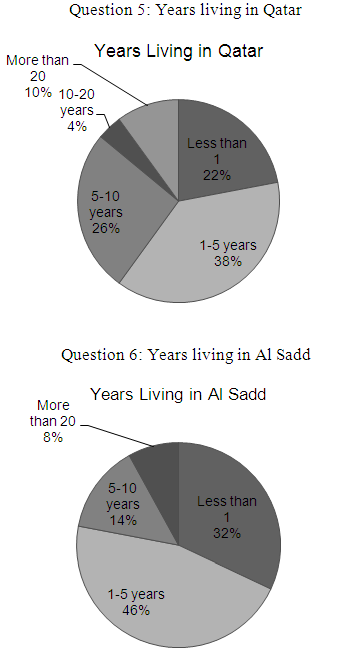 In question 5 and 6 the main purpose is to find the users years of experience with Al Sadd area and the years living in Qatar question is intended for foreigners living in that area. Themore familiar they are with the area, the more aware they are of the pros and cons of Al Sadd and the aspects in need of improvement.
In question 5 and 6 the main purpose is to find the users years of experience with Al Sadd area and the years living in Qatar question is intended for foreigners living in that area. Themore familiar they are with the area, the more aware they are of the pros and cons of Al Sadd and the aspects in need of improvement.  About 44% of them take 15-30minutes to arrive in Al Sadd, 30% take 10-15minutes, 22% take 5-10minutes and a minority of 4% takes an hour. , The findings of question 9 in the questionnaire were that only 42% of them are residents of Al Sadd and 58% are not resident of Al Sadd.
About 44% of them take 15-30minutes to arrive in Al Sadd, 30% take 10-15minutes, 22% take 5-10minutes and a minority of 4% takes an hour. , The findings of question 9 in the questionnaire were that only 42% of them are residents of Al Sadd and 58% are not resident of Al Sadd.
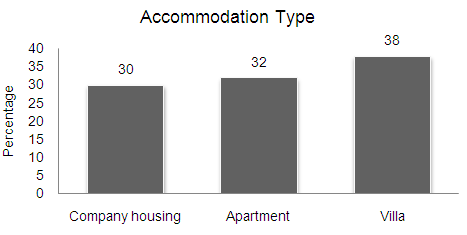 The largest percentage of respondents live in villas about 38% of them, 32% live in apartments and 30% of them live in company housing.
The largest percentage of respondents live in villas about 38% of them, 32% live in apartments and 30% of them live in company housing. In question 12, the majority of the respondents answered that their houses were rented (92% of them) and a minority of 8% answered that they own their houses. Following this question, question 13 asked them to divulge whether the company covers their housing expenses or by themselves that is a strong determinant of their locational choice in regards to Al Sadd area. The findings are that: 66% of them answered that their company is responsible for housing expenses, whereas 34% cover their housing expenses themselves.
In question 12, the majority of the respondents answered that their houses were rented (92% of them) and a minority of 8% answered that they own their houses. Following this question, question 13 asked them to divulge whether the company covers their housing expenses or by themselves that is a strong determinant of their locational choice in regards to Al Sadd area. The findings are that: 66% of them answered that their company is responsible for housing expenses, whereas 34% cover their housing expenses themselves.
 The purpose of question 15 is to get information for the reason behind their respective location in Al Sadd or neighboring locations; 42% chose travel distance as the main reason, since it is located near their working places. Rent came in second place with 22% and there is a tie between personal preference and other choices such company provided accommodation with 18%.Question 16: Rank in order of importance the reasons for you to be located in Al Sadd.
The purpose of question 15 is to get information for the reason behind their respective location in Al Sadd or neighboring locations; 42% chose travel distance as the main reason, since it is located near their working places. Rent came in second place with 22% and there is a tie between personal preference and other choices such company provided accommodation with 18%.Question 16: Rank in order of importance the reasons for you to be located in Al Sadd.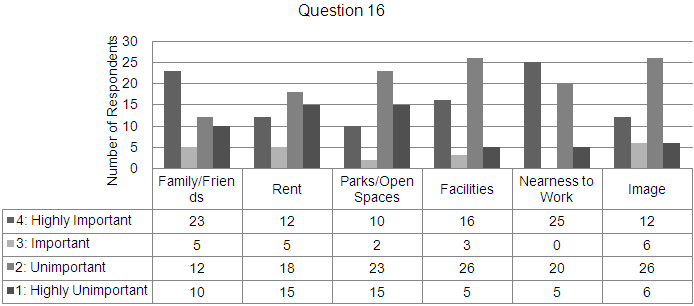 Question 16 was a ranking question where respondents are supposed to rank the factor behind their locational choice with regards to importance. The factors mentioned are family/friends, rent, park/open spaces, facilities, nearness to work and image. According to findings the ranking from is as follows: Nearness to work à family/friends à facilities à rent à image à parks/open spaces.Question 17-20: Overall satisfaction questions
Question 16 was a ranking question where respondents are supposed to rank the factor behind their locational choice with regards to importance. The factors mentioned are family/friends, rent, park/open spaces, facilities, nearness to work and image. According to findings the ranking from is as follows: Nearness to work à family/friends à facilities à rent à image à parks/open spaces.Question 17-20: Overall satisfaction questions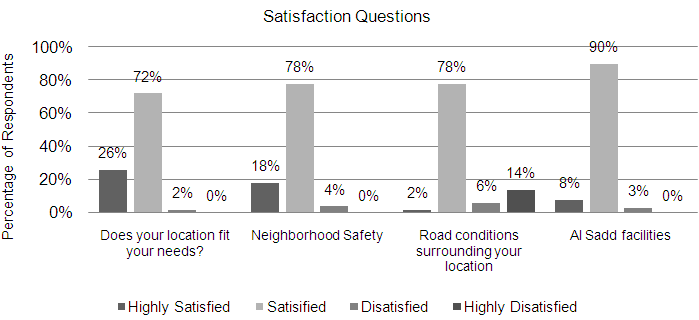 The general response of Al Sadd users is that they are generally satisfied with the area in terms of their needs, neighborhood safety, road conditions and Al Sadd facilities. However, several comments from the respondents stated that they have a few complaints regarding the road conditions and lack of sufficient parking spaces. The roads in Al Sadd are very narrow and are overcrowded most of the time.
The general response of Al Sadd users is that they are generally satisfied with the area in terms of their needs, neighborhood safety, road conditions and Al Sadd facilities. However, several comments from the respondents stated that they have a few complaints regarding the road conditions and lack of sufficient parking spaces. The roads in Al Sadd are very narrow and are overcrowded most of the time.5. Discussion
- In relation to the functional aspects of the area and the questionnaire, huge number of the respondents was found to live in company provided housing near their place of work. While interviewing a female Sri Lankan receptionist that works in Royal Plaza in Al Sadd, she stated that her housing is right beside her working place and many of her colleagues live there as well. It is efficient for her employer to locate there, which saves energy and money required for commuting. Al Sadd has different uses and different groups of people and having such diversity in the area is sustainable both on the short and long term. Cars and buses are the main modes of transportation currently while others are still being developed. In the questionnaire, 42% of the respondents live and wok in Al Sadd, which facilitate the need for developing further pedestrian networks and bicycle paths to reduce car use. In fact, 42% of them chose travel distance as the main reason for them to live in Al Sadd. There are a lot of in-group activities of the residents, for instance people of similar ethnicities and background naturally group together. However, the urban fabric of Al Sadd does not help foster further interactions between different groups of people.
6. Conclusions
- Summary of findingsThis paper focused on sustainable urbanism, in particular the social sustainability of Al Sadd neighborhood in Doha, Qatar. Several reasons for the existing urban form were found from the literature review. These were presented and discussed in the paper with the aid of the questionnaire, which was to check the information collected and assessed from secondary sources. The urban form analysis, derived from the literature review about Al Sadd, covered the morphology, including housing and demographic analysis, economy, means of transportation, whilst, the direct walk through observations covered: functional aspects, services and infrastructure, movement and transportation, land use, social aspects, planning and zoning, landscaping, designing, energy and waste. The existing land use of Al Sadd area is of a mixed-use nature, combining the functions of residential, commercial and institutional. The architectural forms of the area reflect the transition and evolution of built form in Doha. There are different forms of buildings ranging from old looking buildings dating back to the 1950s right after the oil discovery, to modern looking buildings of glass and steel, and some hybrid built forms of architecture today. However, often it is hard to distinguish office space, from commercial or residential uses due to repetitive, modern, western styles. Also, there are a lot of ongoing construction projects in the Al Sadd area, which cause streets to either shrink in size or to be closed temporarily. The high level of construction and business traffic therefore often leads to congestion. There are insufficient parking facilities, such that the minimal pedestrian paths are often used as parking spaces. Safety of women and children are not catered for, due to the predominant commercial, and business nature of the area, narrow streets and construction sites, and the previous dominance of men, often migrant workers or expat professionals, although our sample showed that a significant amount of women also now use the area. Al Sadd area also exhibits a severe lack of open neighborhood areas; green landscaping including shade; pavements, and street furniture, although the signposting is quite good. Like most of Doha, there is a lack of facilities to separate recyclable rubbish.RecommendationsAl Sadd area is used by people with a wide variety of cultural backgrounds, as shown in the district analysis and confirmed by questionnaire findings. Each cultural group demands and prefers different things, and their needs should be considered in the urban planning of the Al Sadd area, as it is one of the prominent business districts of Doha, along with the West Bay. Multiple use of the spaces should be created and maintained, with consideration given to the safety of pedestrians. However, there is a need for better maintenance, and in some cases renovation and renewal of, and improvement to the older architecture and urban space in accordance with the required land use, as well as a need to replace outdated infrastructure. The introduction of short-term rental apartment buildings and more taxi ranks and bus stops would also help to promote tourism and related activities and the openness of the area would attract more people for leisure to the heart of the city to help it regain its lost vitality. Thus, the economy will thrive again due to the influx of people, when the transport and infrastructure can support this.The respondents to the questionnaires were actually generally satisfied with the area, except for the lack of parking facilities. The convenient access to work, family and friends and facilities such as shops and restaurants and hospital, plus the low rent were their main reasons for being resident in the Sadd area, rather than the image or the level of green public space. The priority therefore seems to be to increase the multi-storey car parking facilities that do not obstruct the urban fabric. A huge effort should be put into the maintenance of roads to improve the condition of the area. The development of alternative transport systems should help to relieve some of the congestion, if enough people use it. It is likely that the users of the area would benefit from more, and safer, comfortably walkable (eg. Shaded) pedestrian pathways and crossings, linking meeting areas such as small parks, car parks, shops, and touristic open areas. These should have better street lighting and furniture such as seating and small tables, safe playgrounds, bins and recycling banks. Bicycle use should be encouraged, through safe bicycle lanes, bike signals, and parking areas, further reducing motor vehicle use. This would all encourage better community interaction, as well as attracting more families to the area, due to the greater livability and function of the location as a residential area. This in turn increases the social sustainability of Al Sadd, which is a first step towards environmental and economic sustainability.
ACKNOWLEDGEMENTS
- We would like to acknowledge the support of Qatar University for creating an environment that encourages scientific research. This study was developed as an assignment for the course “Urban Design in Practice” as a part of the Master in Urban Planning and Design Program at Qatar University. Also, we would like to acknowledge the effort of the people working at MMUP for their collaboration – for sharing relevant visual data and important documents for the purpose of this research study. Finally, the authors thank the anonymous reviewers for their comments, which contributed to an improvement of this paper.
Appendices
Appendix I: List of Figures
 | Figure 1. The land use of Al Sadd area Source: MUPP |
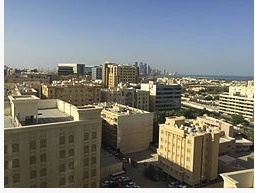 | Figure 2. The architecture style in Al Sadd area |
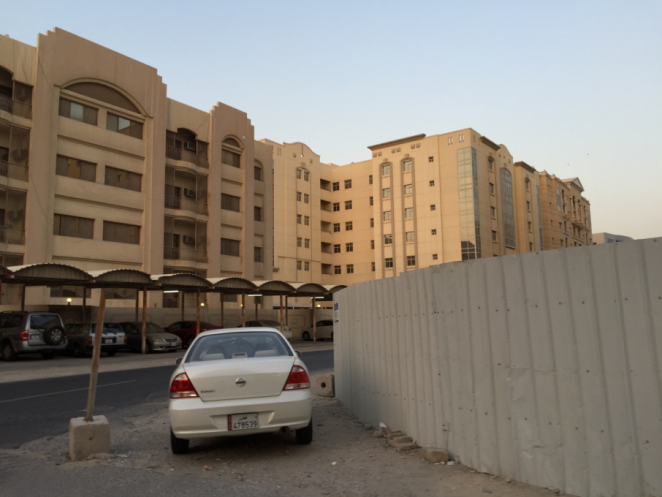 | Figure 3. Residential Mid-rise Apartments |
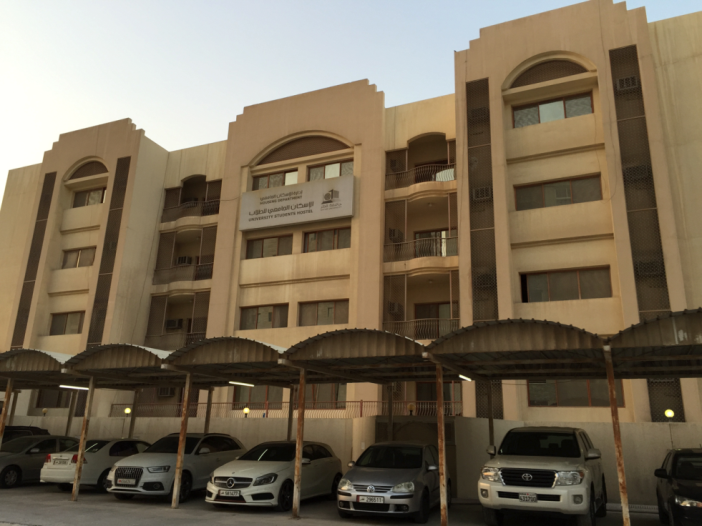 | Figure 4. Qatar Male Students Hostel |
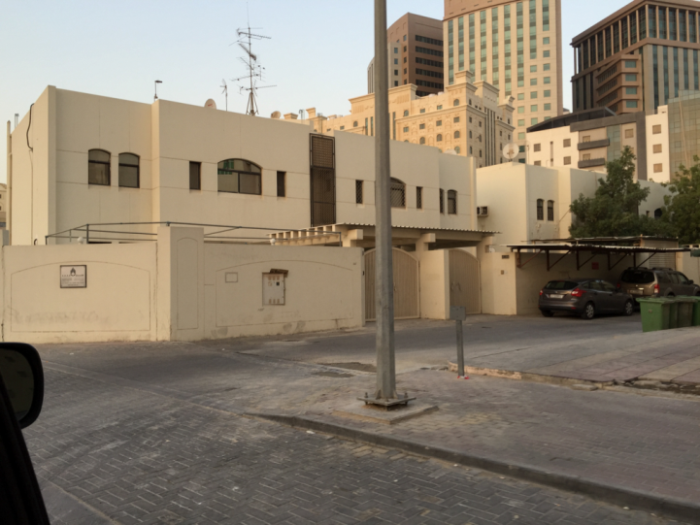 | Figure 5. Villas |
 | Figure 6. Qatar Population Growth Rate by Years, Source: Statistics Authority, unpublished data, 2012 |
 | Figure 7. Economically Active Population by Nationality and Sector (%), 2011, Source: Statistics Authority, labor force survey, 2011 |
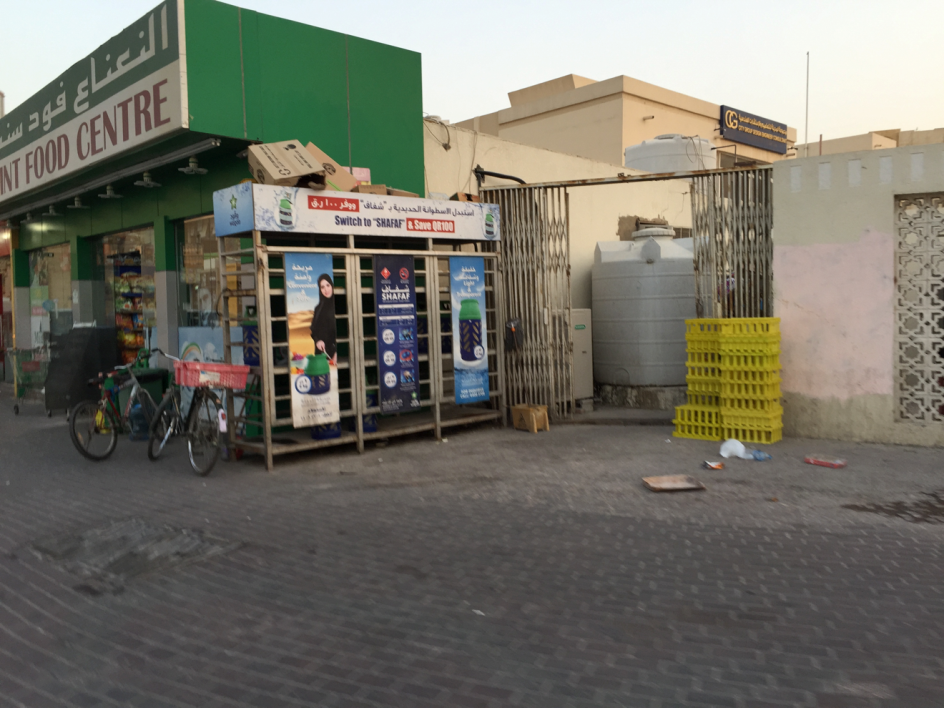 | Figure 8. Supermarket foyer |
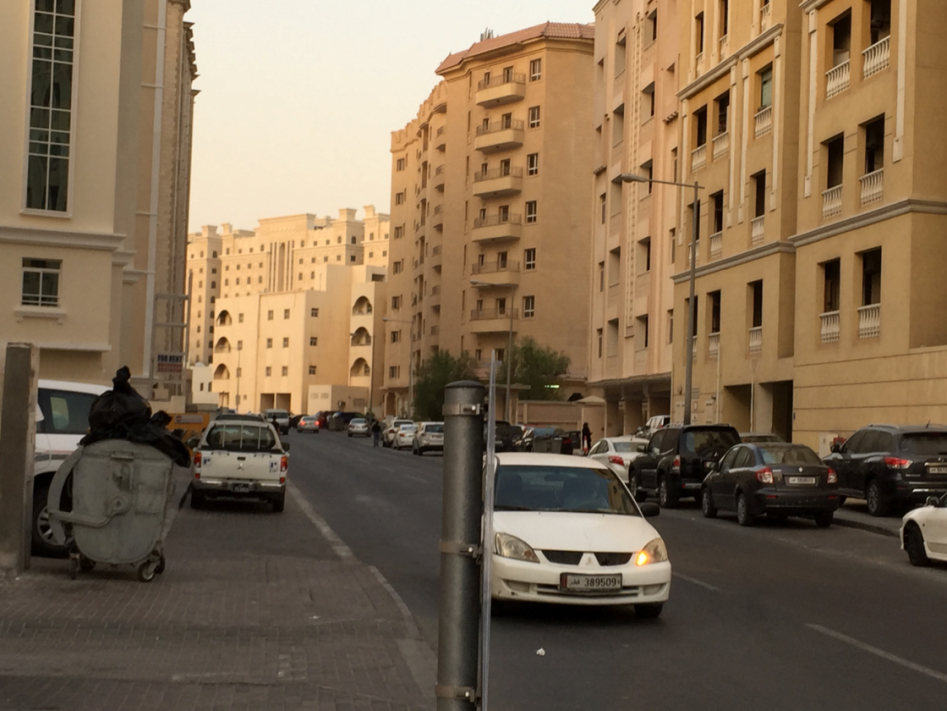 | Figure 9. A series of similar looking apartments |
 | Figure 10. Public transportation in traffic junction |
 | Figure 11. Inadequate Parking Locations |
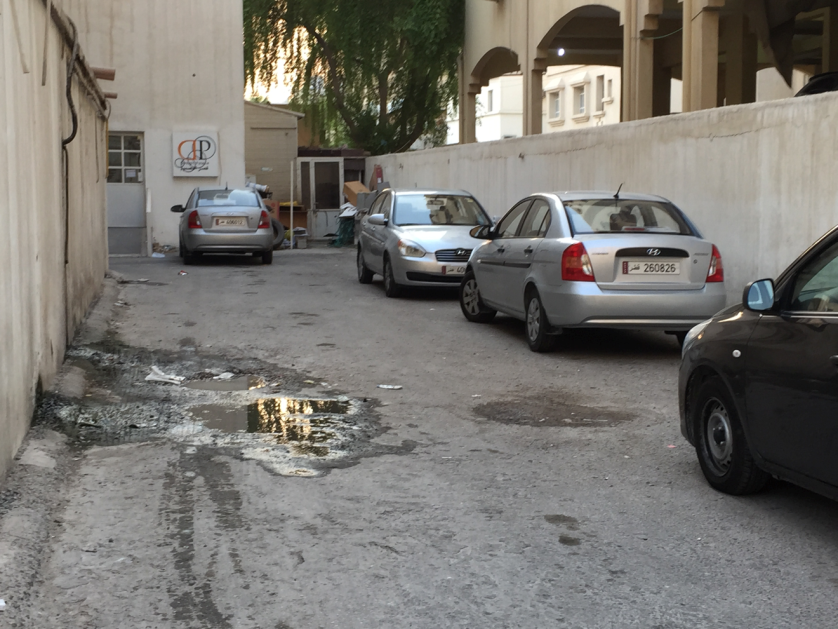 | Figure 12. Sewage Spill overs |
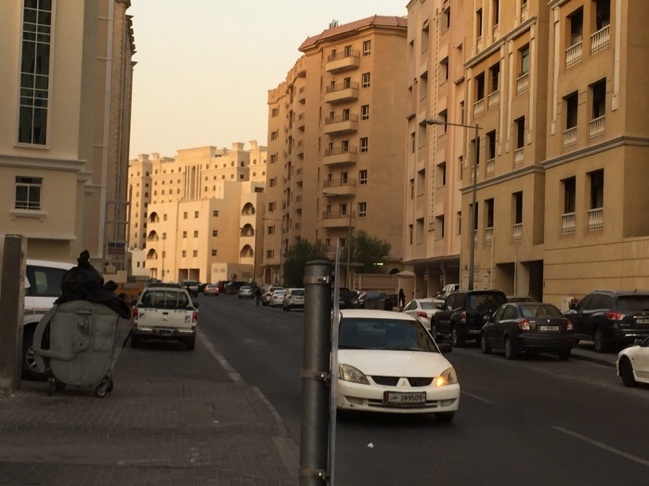 | Figure 13. The western modern style in Al Saad area flats |
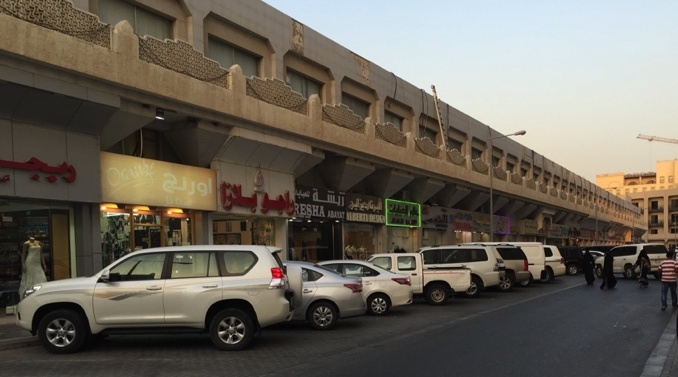 | Figure 14. The repetition in the shops faced |
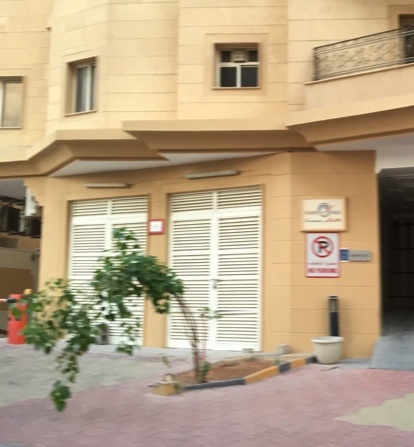 | Figure 15. Plant in Al Saad area |
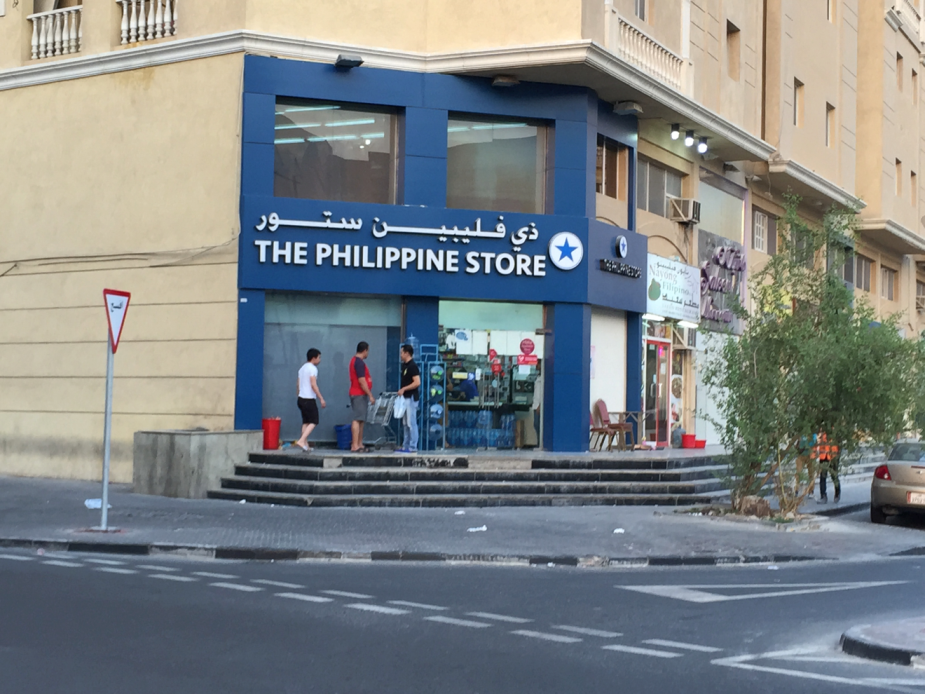 | Figure 16. Filipino Supermarket |
 | Figure 17. An example of a meeting point between the apartments |
 | Figure 18. The trash containers |
Appendix II: Questionnaire Sample
- Assessment of Urban Qualities of Al Sadd AreaThe urban areas in Qatar, similar to other urban areas around the world, are influenced by two main variables: physical and functional qualities, and social, and cultural attributes. The research focuses on the functionality of urban spaces in Qatar as defined by its physical form and social-cultural attributes in order to sustain it. Thus, it is important to understand the pattern within these urban areas and how it is orchestrated. The urban area addressed in this research is Al Sadd area located in Doha, Qatar. Given that, the research will lie heavily on people's perceptions of a specific urban space as influenced by their cultural-social background. The objective of this research is to take a deeper look at urban quality within the region, learn what is meant by them, who construct them, what are the parameters those are controlling those areas and what makes them sustainable.The research will depend on the data collected from both secondary and primary resources. The data collected are processed and analyzed in relation to the literature reviewed and the different theories presented. Observations are carried out from several points in Al Sadd area to understand the context in which those urban areas are constructed and how are they influenced by the parameters defined in the research and what makes them sustainable in the long term. This questionnaire will only take five minutes of your time. This questionnaire is strictly for educational purposes.
 16. Rank in order of importance the reasons for you to be located in Al Sadd.
16. Rank in order of importance the reasons for you to be located in Al Sadd.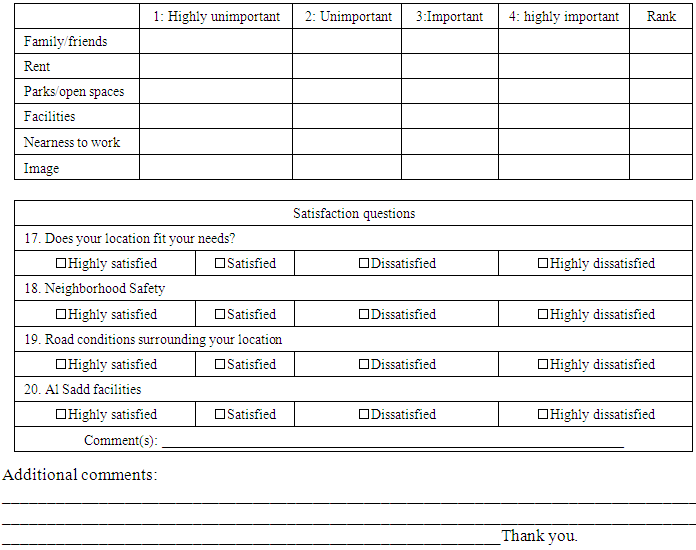
Notes
- 1. From Beate Littig, Erich Grieβler 2005 Social sustainability: a catchword between political pragmatism and social theory, International Journal of Sustainable Development 8(1-2):65-79, p 72.2. Definition obtained from: What is Placemaking? Retrieved March, 2015 from [http://www.placemakingchicago.com/about/]
 Abstract
Abstract Reference
Reference Full-Text PDF
Full-Text PDF Full-text HTML
Full-text HTML